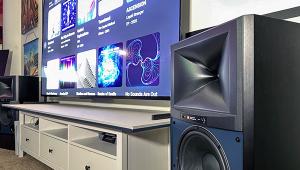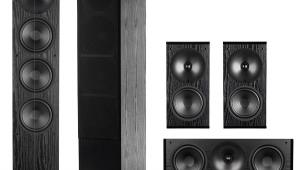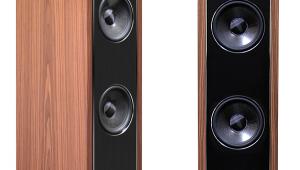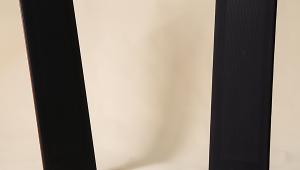PSB Imagine T2 Speaker System
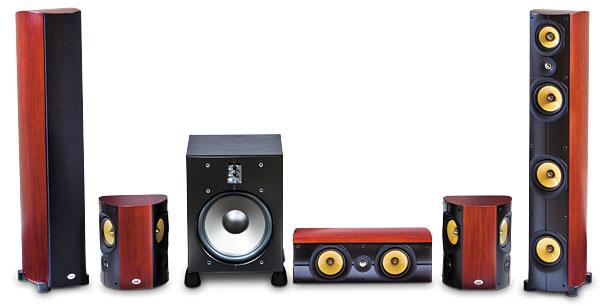
At A Glance: Independent ported chambers for each woofer • Dual five-way gold-plated binding posts for biwiring or biamping • Five-way transitional design
Paul Barton is a nutcase. Oh, sure, he’s soft-spoken, ultra-smart, and intensely passionate about sound. (In the late 1960s, 11-year-old Barton started building speakers with his dad in their workshop because other speakers “didn’t sound natural.”) But that’s just a cover. I don’t know how else to explain the fact that Mr. Barton (the “P” and “B” of PSB Speakers—with his wife, Sue, providing the “S”) has spent so much of his life locked away in the anechoic chamber and testing/listening labs of Canada’s federally funded National Research Council (NRC) in Ottawa, Ontario. In fact, according to PSB, although folks from other speaker companies (such as Paradigm, Energy, Mirage, Snell, and Aperion, to name a few) have traipsed through the NRC’s Acoustics and Signal Processing Department’s doors, since the late 1970s, Barton “has spent far longer in the chamber and lab than any other speaker designer.” So rather than skiing, hunting, fishing, playing hockey, and/or drinking beer all day like real Canadians do, Barton chose to play in an anechoic chamber. As I said, he’s a nutcase.
But I mean that in the most complimentary, panegyrical way because Monsieur Barton put all that time to good use measuring speakers in the acoustically sterile atmosphere of the NRC’s anechoic chamber and then doing countless double-blind listening tests—I have this image of people sitting in a room being given a piece of cheese every time they pick the right speaker, but that’s probably not the way it’s done—in order to come up with unique criteria for what’s important in a loudspeaker and how to correlate speaker test measurements with real-world people’s listening preferences. Perhaps not surprisingly, a loudspeaker’s power response, dynamic range, and, especially, dispersion characteristics rank extremely high on the list of critical elements.
Imagine-nation
It’s easy to imagine that Barton’s years locked away in a lab would result in a range of speakers that might well sound great but would probably be nothing short of butt-ugly—in other words, the standard-issue, black-grilled, plain-Jane, rectangular coffins for which significant others might grudgingly give up floor space in return for other concessions. After all, pocket-protector-wearing, slide-rule-swinging, techno-geek research types aren’t known for their sense of fashion. (No offense to Barton, who was wearing neither a pocket protector nor a slide-rule holster when I met him earlier this year.) The Imagine series speakers’ looks are far from that, however, because PSB turned to David Farrage and his New York design firm, DF-ID, to provide the industrial design.
I’ve never met Farrage, but based on the Imagine series speakers and the work he’s done for other clients (including Sony, Samsonite, NAD, Lamborghini, and Movado), I’m quite certain a pocket protector is not part of his wardrobe. Farrage deserves many kudos for the organic beauty of the gentle curves and the finely executed details of the Imagine speakers. The Imagine T2 tower speakers, for example, don’t unabashedly draw attention to themselves (however well deserved) as do, for example, some Sonus faber or Focal speakers. Nor are they a more subtle technology statement, such as the look of the narrow aluminum cabinets of Definitive Technology’s Mythos speakers. Instead, the visuals of PSB’s Imagine speakers fall somewhere in between—for the most part disappearing into the room but, upon closer inspection, revealing an understated beauty and elegance.

The Imagine T2 ($3,850 per pair) is the latest addition to—and the new flagship speaker of—PSB’s small group of Imagine speakers, which includes the smaller Imagine T tower, two pair of monitor speakers, two center channels, and a unique tri-mode surround speaker. For this review, PSB included the larger Imagine C center ($930) and a pair of the tri-mode Imagine S surround speakers ($1,360 per pair). All the speakers share the inspired design elements, as well as the same family of drivers.
The Imagine T2 is tall (a little more than 40 inches) and slender (a bit more than 8 inches at its widest point) with the sides sloping from the curved, 2-inch-thick, MDF front baffle toward a narrow, rounded back. As far as I could tell, the only flat surface is found on the bottom of the cabinet. Greg Stidsen, PSB’s director of technology and product planning, explained that the cabinets start out as seven layers of thin MDF that are form-fit and pressed into shape. The cabinets are then placed inside the industrial equivalent of the microwave oven on your kitchen counter to cure the glue between each layer. Then a CNC machine drills the holes for the drivers, and the cabinet’s wood veneers are individually hand-sanded and finished. The result is an elegant, well-proportioned tower that, even when toed in, shows a thin outline of wood on either side of the black grille when viewed from the main seating position. The tower rests on four round feet located at the bottom corners of the cabinet with a tap in each that accepts either the included spikes or rubber pads.
Five-Way Trans-What?
PSB describes the T2 as having a “unique five-way transitional design.” Near the top of the cabinet is a 4-inch clay/ceramic-filled polypropylene cone midrange driver mounted directly above a 1-inch titanium-dome tweeter, an arrangement that, according to PSB, results in a more uniform output with little cancellation, whether the listener is seated or standing. Lined up below the tweeter are three active 5.25-inch clay/ceramic-filled polypropylene cone woofers. (PSB says the surface area of the three woofers is equivalent to a single 15-inch driver but much more responsive.) Internally, each driver is mounted in its own discrete chamber, and each woofer chamber has its own rear-facing port. There are multiple benefits that come from this approach. For example, the bracing required inside the T2’s cabinet to create individual chambers adds significantly to the rigidity of the entire cabinet. The five-way transitional design refers to the fact that the woofers cross over at different frequencies. Each woofer’s output is specifically tuned—based on its position in the cabinet relative to the floor—to compensate for the suck-out, or cancellation, of particular frequencies caused by reflections off the floor. While PSB knows the exact distance from each woofer to the floor, the company can only guess at what the rest of your listening room will be like. So PSB includes a rubber port plug with the T2s that you can use like a cork to seal off one (or more, using additional plugs from PSB) of the ports to tweak the bass response. To plug or not to plug, as well as which port(s) to plug will depend on you room’s acoustics and your tastes.





